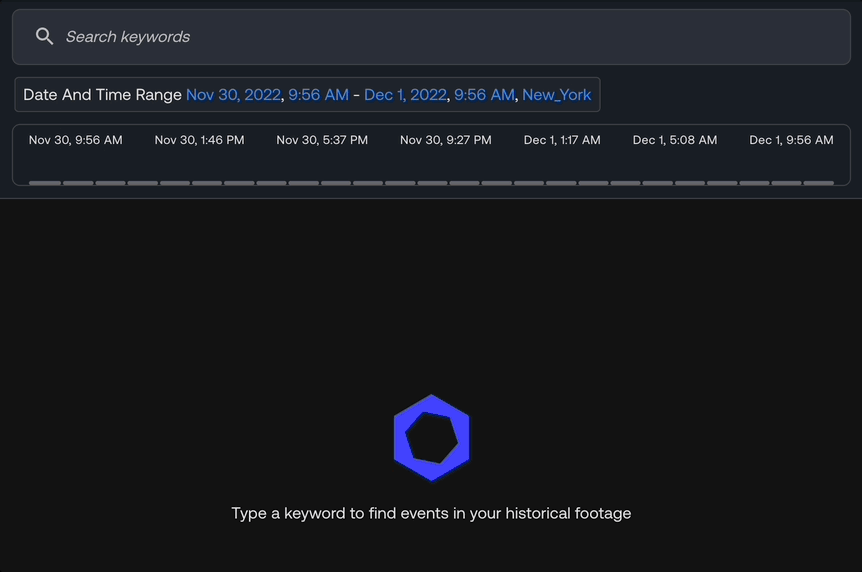This is the third blog in our series about AI’s impact on mitigating active shooter incidents.
- Read the first one about active shooter detection & prevention.
- Read the second one about responding to active shooter incidents.
In an alarming trend, the US has witnessed a staggering 103% surge in active shooter incidents over just four years, spanning from 2018 to 2021. Conducting proactive detection and forming a rapid response is essential to mitigating these tragic events. However, after the detection and response phase, the work of security teams is far from over.
Carrying out swift and comprehensive investigations is not only essential for uncovering vital information about the culprits and their actions, but also for averting any future threats.
Unfortunately, the conventional tools and techniques used for video reviews often entail slow, laborious, and reactive processes. It can take hours — even days — to complete a single investigation. Due to these shortcomings, investigations are significantly delayed, carried out long after the shooting has already occurred and the damage has been inflicted.
From here, AI becomes indispensable. AI-powered forensics replaces reactive and delayed processes with real-time investigations, allowing security teams to unearth critical details as events unfold, and vastly accelerating post-incident searches.
We’ll explore the key role that AI plays in the investigation process, shedding light on how this technology is a force multiplier for security teams in times of crisis and ultimately contributes to a proactive approach for mitigating active shooter incidents.
You need real-time, rapid investigations. Here’s why:
If you’re a physical security professional, you’re all too familiar with the challenges of conducting video investigations. Following an incident, operators must tediously sift through hours of footage, one camera stream at a time, in an attempt to comprehend what transpired and who was responsible.
It’s a painful process of checking your cameras one by one, pinpointing the correct time frame, extracting video data from the video management system (VMS) and uploading it into the forensics tool, and then, when ready, searching videos frame-by-frame — and crossing your fingers that you don’t have to run additional video extractions.
Now, take this process and apply it to a crisis like an active shooter incident. These incidents happen in an instant, ending just as quickly as they began; 70% of active shooter incidents end in 5 minutes or less, and 37% end in 2 minutes or less. Operators must search through hours of footage just for this minutes-long incident, painstakingly replaying footage to identify the early warning signs that marked the incident’s onset and its ultimate conclusion.
If you’re thinking, “There must be a better way,” fortunately, now there is. The solution lies in leveraging AI-powered technology to investigate incidents in near real-time. This approach streamlines the process to such a degree that operators can practically follow close behind an incident as it unfolds. Plus, an AI-powered forensics tool unlocks the ability to easily and efficiently identify vulnerabilities to guard against future crises.
Where traditional investigations fall short
Investigations into physical security incidents demand prompt action — an element that conventional tools fail to deliver. Delayed, non-intuitive investigations impede your team’s ability to gain a comprehensive understanding of the crisis. It even becomes cost and time-prohibitive to investigate low-urgency threats, meaning incidents like petty thefts may never get resolved.
Today’s investigations are most often hindered by several factors:
- Tools create a tedious, reactive process: Operators are stuck searching each video stream, examining hours of footage, often with multiple logins across numerous sites and appliances. This time-consuming process entrenches security teams in their reactivity, with no way to analyze incidents as they occur.
- Post-incident investigations are slow and delayed: Due to the slowness of most investigation tools and the drawn-out processes that they foster, post-incident investigations take place long after the event concludes.
- Technology isn’t intuitive: Conventional investigation tools aren’t made with the end user in mind. They lack the intuitiveness required to directly search for specific elements within video footage or to answer pertinent questions.
In the face of these limitations, AI-powered technology emerges as the key to conducting proactive and expedited investigations of active shooter incidents.
How AI improves investigations for active shooter incidents
AI technology offers a vital solution to the shortcomings of traditional video investigation methods. With AI, investigations are fast and intuitive, serving as important tools for uncovering the details of active shooter incidents and pinpointing vulnerabilities in security policies. Here’s how this works:
Conduct forensic searches as events unfold
It takes law enforcement an average of three minutes to reach the scene of an active shooting. However, even with a swift response, active shooters can still cause significant harm.
The ability to instantly retrieve vital details regarding the perpetrator’s movements and the locations of wounded victims provides your security team with a massive advantage. This proactivity allows you to effectively mitigate the incident before officers even arrive on the scene and equip officers with all of the information needed to apprehend the shooter. AI technology makes this possible.
By incorporating AI into your security infrastructure, there’s no need to wait until after an active shooting has occurred and the damage has been done to initiate an investigation. AI allows your security team to conduct instantaneous forensic searches to keep personnel informed in real time as the events unfold.
With Ambient.ai’s AI-powered forensic investigations, it’s only a few minutes from the time something occurs in the real world to it being searchable within Ambient. The platform enables security personnel to quickly retrace active shooter incidents, unearthing details that go beyond the perpetrator’s actions to include information on accidents, injuries, or where groups have assembled.

Expedite post-incident investigations
Once your security team has alerted authorities, first responders have arrived, and the perpetrator has been immobilized, there’s a pressing need for a post-incident investigation. This investigation will provide concrete answers to urgent questions: “How did this incident start?” “Are there any critical details we missed during the events?” and, “How can we prevent this in the future?”
AI accelerates the post-incident investigation process — no need to wait for video processing. Ambient.ai continuously and automatically processes the video so that your security team can begin reviewing the footage immediately.
Plus, Ambient.ai’s intuitive, event-based search functionality creates a remarkably user-friendly investigation process. The forensics tool makes it easy to navigate between cameras and quickly filter by time. The platform also enables you to search for specific characteristics or behaviors, like “Person Carrying a Bag,” and then rapidly filter by cameras and time.
Identify vulnerabilities to enhance security measures
Conducting investigations into security incidents should go beyond uncovering immediate facts; it should reveal vulnerabilities, weaknesses, and opportunities for smarter operational decisions and fortified security measures in the future. This ensures the protection of your organization and community from experiencing any further devastation from active shootings.
AI-powered technology enables swift searches through historical footage to retrace the perpetrator’s actions and pinpoint early warning signs that led to the crisis. Did an unlocked door play a role? Did the intruder breach the perimeter by jumping a fence?
Ambient.ai’s access control integrations are especially valuable in this regard. By integrating with widely used access control systems, Ambient.ai contextualizes access control alarms with video footage to detect precursors of active shooter incidents. For example, perhaps your security team identifies the perpetrator tailgating into the building or raising a “Door Forced Open” alarm minutes before brandishing their weapon.
Based on the precursors that you identify, you can decipher where the gaps in your security infrastructure lie and appropriately fortify your security measures for a safer, more secure future.

What your active shooter investigations are missing
During an active shooter incident, time seems to fly by in a blur, but then slows down to a crawl once it’s over. In both the chaos and the aftermath, AI technology emerges as a vital tool for rapidly investigating what has transpired.
An AI-driven approach offers real-time and swift investigations, intuitive searches, and the ability to identify vulnerabilities for enhanced security measures.
Watch our on-demand webinar for expert insights on how AI can mitigate active shooting episodes and save lives.












